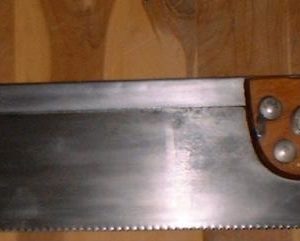I found one of my Dads saws the other day,I cleaned it up with a wire brush and waxed it. I’m not sure what you would call it a Back saw or a Tenon saw. It has 12 tpi. I don’t have a clue what it is- it has” warranted superior” on one of the handle screws. Is dull as a froe would like to have it sharpened to use for dovetails & tenons.Should I have it sharpened for Ripping?
Thanks for your help
Ron















Replies
ttt
Hi Ron,
loks like you have a Disston back saw. check out pete taran's web site (below) to nail down the type. could be worth a few bucks. He has some great info on how to sharpen them.-Eric
http://www.vintagesaws.com/
Eric.
If indeed he is correct in stating that the saw medalion says "warrenteed superior" then the saw is a superior not a Disston. I have several of both and they are made by different manufacturers. Superior is a good saw though.
Mark
Dear Professor, I stand corrected.. I am unfamiliar with the supeior brand..from the photo it looked similar to the Disston mark -Eric
Thanks for the link Eric I have an old Ditson rip saw I would like to check out.
Thanks for the info. everyone I did not know what to do - sent it to the sharpener today to sharpen as is,I didnt think it would be good to change it to a rip cut.
Ron
Eric.
if you have a chance to get on Ebay you can get pretty good deals on them. They are not as highly sought after as the disstons. They were also made in great numbers so there are still a lot of them left out there. I confess I have a handsaw fetish though I do use them quite a bit. I don't buy them just for wall hangers. There is an Amish fellow local to me who does a great job sharpening them.
Mark
Ron,
If this is a user (i.e. not of great value) then whether to file it rip or crosscut depends on what you're going to use it for.
For cutting dovetails you want rip teeth, because dovetails are sawn into the end of the board. For cutting tenon cheeks you also want a rip saw because, like cutting dovetails, you'll be sawing along the grain. For tenon shoulders, sawing across the grain, you ideally want a crosscut saw.
I can't tell from the picture how large your saw is. Generally you want a dovetail saw to be on the smallish side, around eight or ten inches long. You don't need to saw to any great depth, and the smaller saw is easier to handle. The same is true of tenon shoulders: you don't need to saw at all deep, so a smaller saw often works better. Sawing tenon cheeks calls for deeper cuts, as a rule, so you need a larger saw--most particularly you need enough room from the teeth to the back to be able to saw the complete depth of the cheek. My tenon saws are around fourteen inches long and are capable of cutting three or more inches deep.
The ubiquitous "however": you can cut tenon shoulders with a rip saw and you can cut dovetails and tenon cheeks with a crosscut saw. But not having the right saw for a cut makes the job a bit more difficult.
It's your call, depending on whether your saw is a collectable/valuable item and what work you intend to do with it.
Alan
This forum post is now archived. Commenting has been disabled